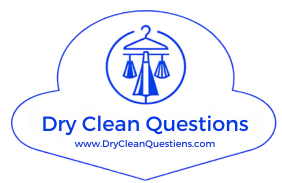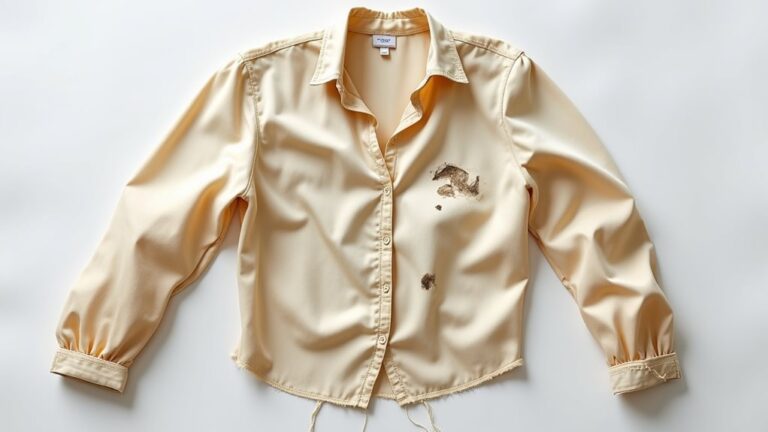When you wash “dry clean only” garments, you’re fundamentally rolling the dice with your wardrobe investment, and the house usually wins. Your silk blouse might emerge looking like a dishrag, while that wool sweater could shrink to toddler proportions, and leather items often crack like desert earth. The gentle solvents used in professional dry cleaning can’t be replicated in your machine, where water and agitation wreak havoc on delicate fibers, causing irreversible shrinkage, color bleeding, and structural damage that’ll leave you wondering why you didn’t just follow those tiny care labels that seemed so crucial.
Understanding Dry Clean Only Labels and What They Mean
When you’re standing in your closet, frantically searching for something to wear to that important dinner tonight, the last thing you want to discover is a mysterious “dry clean only” label staring back at you like a tiny textile gatekeeper.
That little dry clean only tag isn’t there to ruin your evening plans – it’s actually protecting your investment in delicate fabrics like silk, wool, and leather that can suffer irreversible damage from water exposure.
Think of your care label as a garment’s personal instruction manual, written by manufacturers who understand exactly what their creation needs to survive.
While regular washing uses water and aggressive agitation, dry cleaning employs gentle solvents that won’t cause shrinkage, color bleeding, or structural damage, keeping your precious pieces looking pristine for years to come.
Garments with special construction features such as structured blazers, suits with interfacing, and beaded or sequined items require professional care to maintain their shape and prevent damage from the heat of conventional washing and drying processes.
Common Fabric Reactions When Machine Washed Instead of Dry Cleaned

When you toss that beautiful wool sweater or silk blouse into your washing machine instead of taking it to the dry cleaner, you’re basically rolling the dice with some pretty predictable (and disappointing) outcomes that’ll have you questioning your laundry decisions.
The most heartbreaking result is often shrinkage, where your favorite garments literally transform into doll clothes before your eyes, leaving you with expensive fabric that wouldn’t fit your younger sibling 😅.
You’ll also discover the frustrating world of color bleeding, where those rich, vibrant hues you loved suddenly decide to take a vacation, fading into sad, washed-out versions of their former selves or worse, staining everything else in the load.
The reason these disasters occur is that dry cleaning uses specialized solvents and professional techniques that your home washing machine simply cannot replicate, making the damage almost inevitable when you skip the professional route.
Shrinkage and Fabric Distortion
Unless you’ve experienced the heartbreak of pulling a beloved sweater from the washing machine only to find it’s now perfectly sized for your nephew’s teddy bear, you mightn’t fully grasp how dramatically fabrics can transform when they encounter water and agitation instead of the gentle solvents used in dry cleaning.
Shrinkage isn’t just a minor inconvenience—it’s often permanent fabric suicide 💔. When you toss dry clean only clothes into your washing machine, delicate items like wool and silk literally contract their fibers, sometimes dropping an entire size or two.
The fabric distortion that follows is equally devastating, turning your once-flattering blazer into something resembling a potato sack with sleeves, forever altering the garment’s intended silhouette and fit.
While traditional dry cleaning chemical solvents like perchloroethylene effectively clean without water damage, they do carry health considerations that have led many facilities to adopt safer alternatives.
Color Bleeding Issues
Beyond the tragic tale of shrunken sweaters lies another washing machine nightmare that can turn your laundry day into a scene from a horror movie—color bleeding that transforms your pristine whites into a tie-dyed disaster 🎨.
When you ignore those “dry clean only” labels and toss delicate fabric into your machine, you’re fundamentally playing Russian roulette with your wardrobe, because vibrant dyes don’t stay put when exposed to water and aggressive agitation.
I’ve witnessed silk blouses turn neighboring garments into watercolor paintings, and cotton items emerge with faded, uneven patches that looked like they’d survived a paint fight.
Machine washing embellished pieces causes sequins and beads to rub against fabric, releasing their dyes and creating irrevocable damage that no amount of bleach can fix.
Water exposure on these delicate garments can cause natural fibers like wool and silk to contract unevenly while simultaneously releasing unstable dyes that permanently stain surrounding fabrics.
Potential Damage to Different Material Types

When you’re dealing with different fabric types, the potential damage from machine washing can feel like a chemistry experiment gone wrong, and trust me, I’ve learned this lesson the expensive way 😅.
Your beautiful silk blouse can literally fall apart as the fibers break down from water and agitation, while that cozy wool sweater you adore will shrink faster than your confidence when you realize what you’ve done.
Meanwhile, leather items face their own nightmare scenario, cracking and stiffening as the natural oils get stripped away, leaving you with something that looks more like cardboard than the supple material you once loved.
Garments with decorative elements like sequins, beading, or plastic components can suffer even more dramatic damage, as these materials may melt, detach, or completely deteriorate when exposed to washing machine agitation and heat.
Silk Fiber Breakdown
Water breaks down silk’s delicate protein fibers through aggressive agitation, stripping away that gorgeous natural luster you paid good money for.
Without proper care, your silk transforms from luxurious to lackluster.
Here’s what happens during fiber breakdown:
- Loss of natural sheen – that signature silk glow disappears
- Roughened texture – sleek becomes scratchy and uncomfortable
- Weakened structure – fibers become brittle and prone to tearing
- Permanent damage – unlike cotton, silk rarely recovers its original beauty
This is precisely why chemical solvents are necessary for properly cleaning silk garments without causing irreversible damage to the delicate fibers.
Wool Shrinkage Issues
Just as silk suffers from water’s harsh effects, wool faces an even more dramatic fate when you toss it in the washing machine—shrinkage that can transform your favorite sweater into doll clothes.
I learned this lesson the hard way with my grandmother’s cashmere cardigan, watching it shrink thirty percent into something my cat could wear 😅. Wool fibers felt together under agitation and heat, creating irreversible distortion that’ll leave you heartbroken.
Untreated wool is especially vulnerable compared to superwash varieties, making that care label your best friend. When it says “dry clean only,” trust it completely—ignoring those instructions turns your delicate garment into an expensive mistake that no amount of stretching can fix.
Even professional dry cleaning can sometimes cause wool shrinkage if excessive heat is used during the cleaning or pressing stages, though the risk is significantly lower than home washing.
Leather Cracking Damage
While wool’s shrinkage breaks your heart, leather’s response to water will absolutely devastate your wallet and your wardrobe in ways that make shrunken sweaters look like minor inconveniences.
When you expose leather to water, you’re fundamentally signing its death certificate, because the material loses those precious natural oils that keep it supple and gorgeous.
Here’s what happens when water meets your leather treasures:
- Cracking damage appears as the leather dries out completely, creating permanent fissures
- Lost flexibility transforms buttery-soft jackets into cardboard-stiff disasters
- Color bleeding ruins the rich, even tones you originally fell in love with
- Structural deformities warp shapes beyond recognition, making items unwearable
Trust me, I’ve watched expensive leather jackets become expensive mistakes 😅
When Washing at Home Might Actually Work

Despite what those intimidating care labels might suggest, you’ll often discover that washing certain “dry clean only” garments at home can actually save you money, time, and even preserve your clothes better than professional cleaning.
I’ve learned through trial (and occasional error 😅) that delicate clothing labeled “dry clean recommended” usually tolerates gentle home washing beautifully. When you hand wash silk blouses or cashmere sweaters with cold water and mild detergent, you’re actually treating the fibers more kindly than harsh chemical solvents would.
Modern wool and synthetic fabrics often handle machine washing on gentle cycles perfectly fine, while spot cleaning tackles minor stains without full washing. Home dry cleaning kits work wonderfully for lightly soiled pieces, giving you professional-quality results without the hefty price tag.
However, keep in mind that dry cleaning excels at removing oil-based stains that water and detergent might struggle with, so consider the type of soil your garment has accumulated.
Safe Alternatives to Professional Dry Cleaning

Beyond these gentle home washing techniques, you can explore several safe alternatives that’ll keep your delicate fabrics looking fresh without exposing them to harsh professional chemicals or risking damage from improper washing.
- Home dry cleaning kits work wonderfully for lightly soiled garments, giving you professional-level results without leaving your house or spending a fortune.
- Spot cleaning with mild detergent tackles minor stains while preserving fabric integrity, especially on those intimidating “dry clean only” labels.
- Hand washed wool and cashmere often turn out better than you’d expect when treated with gentle detergent and cold water.
- Fabric-specific sprays refresh garments between wears, eliminating odors and wrinkles without any washing whatsoever.
- Eco-friendly dry cleaning methods offer chemical solvents alternatives that are gentler on both your garments and the environment.
When items are heavily soiled or truly precious, though, consulting professionals remains your smartest move.
How to Minimize Risk When Washing Delicate Garments

When you’re standing in front of your closet holding that gorgeous silk blouse or cashmere sweater, wondering if you can risk washing it yourself instead of heading to the dry cleaner, the key lies in becoming a fabric detective first.
Start by reading those tiny care labels like they’re treasure maps, because “dry clean only” means exactly that – no shortcuts allowed.
Before committing to washing delicate garments, conduct a sneaky spot test on a hidden seam with mild detergent and water. If the fabric passes your detective work, use cold water on a gentle cycle, and always tuck your precious pieces into a mesh laundry bag for protection.
Sometimes hand washing becomes your safest bet.
Between professional cleanings, you can extend the life of your garments through proper storage techniques and careful handling to reduce the frequency of expensive dry cleaning visits.
Signs Your Garment Has Been Damaged by Improper Washing

Unfortunately, that sinking feeling in your stomach when you pull a beloved garment from the washer and realize something’s gone terribly wrong is something I’ve experienced more times than I’d like to admit 😅.
Spotting damage from improper washing becomes easier once you know what to look for, and trust me, these signs are hard to miss:
- Size changes – Your garment has shrunk markedly or stretches oddly, particularly noticeable with wool and silk fabric types.
- Shape distortion – Seams pull strangely, shoulders don’t sit right, or the overall silhouette looks completely off.
- Missing embellishments – Beads, sequins, or decorative elements have fallen off or appear loose.
- Color issues – Fading, bleeding, or dye transfer has occurred.
When you should dry clean instead, these damage indicators serve as costly reminders about respecting care labels.




